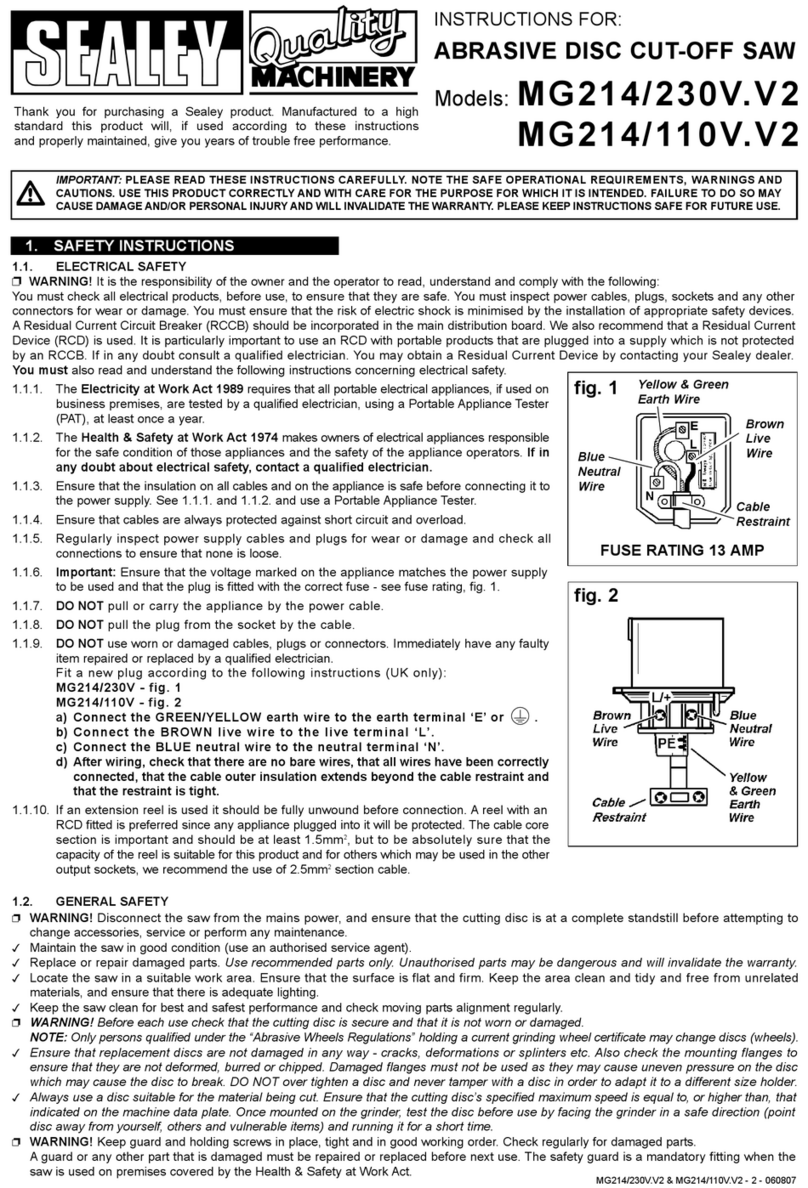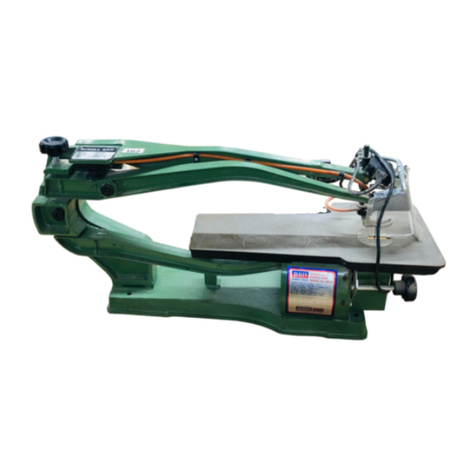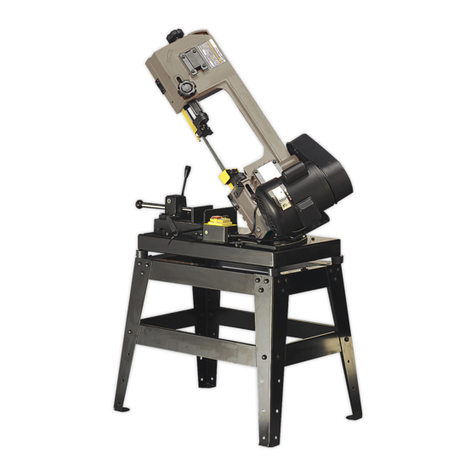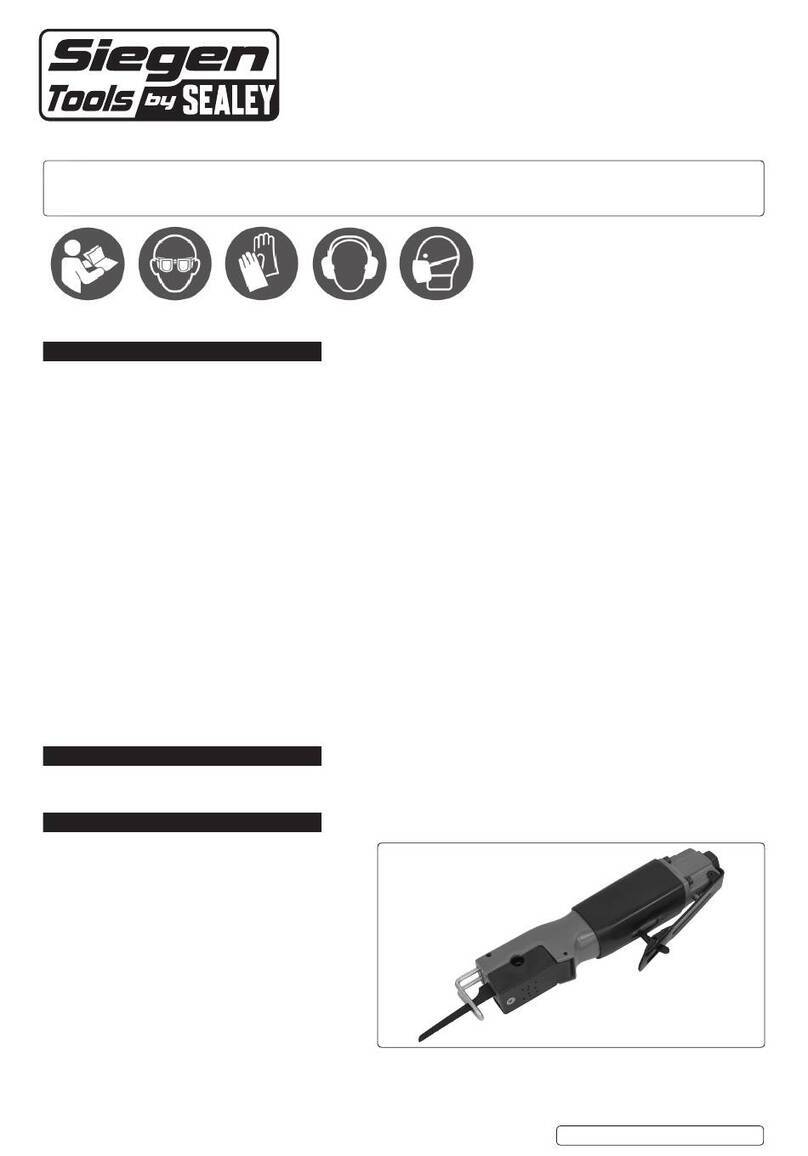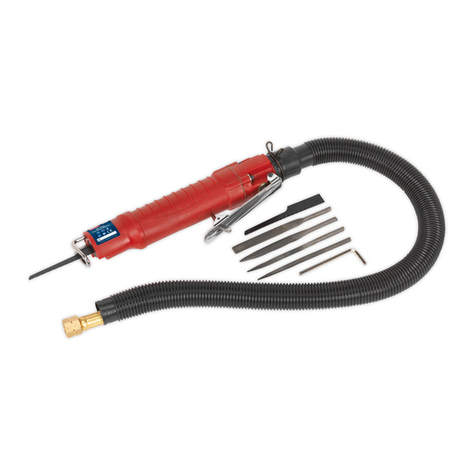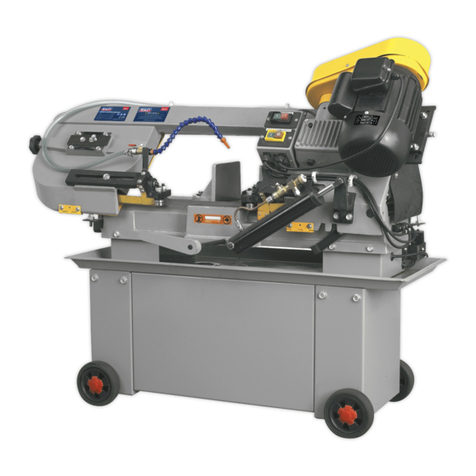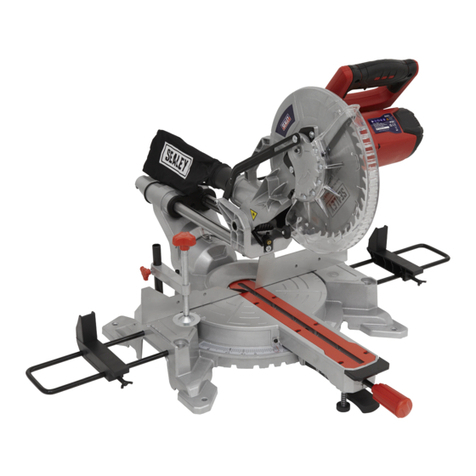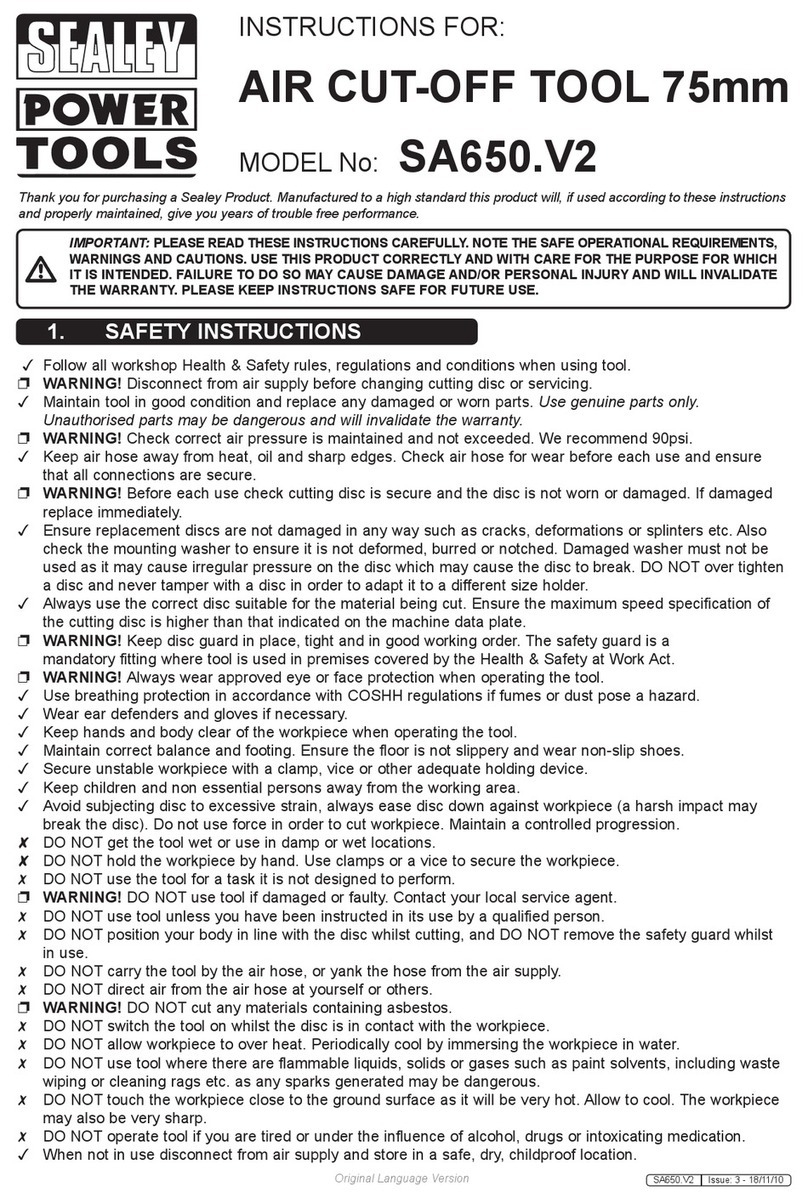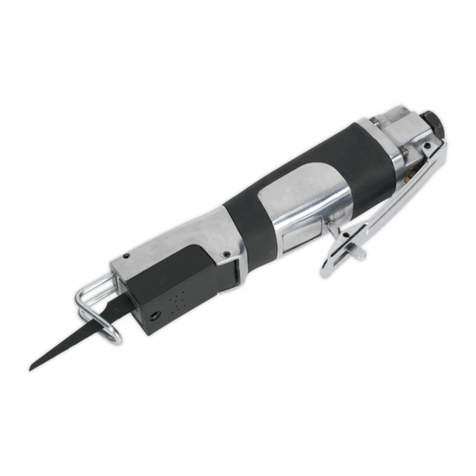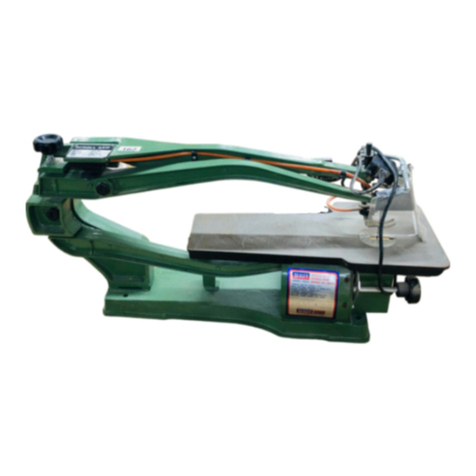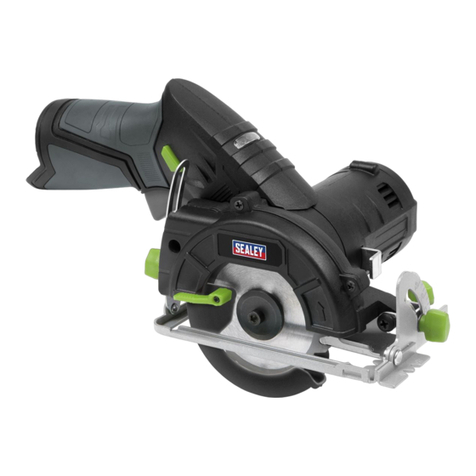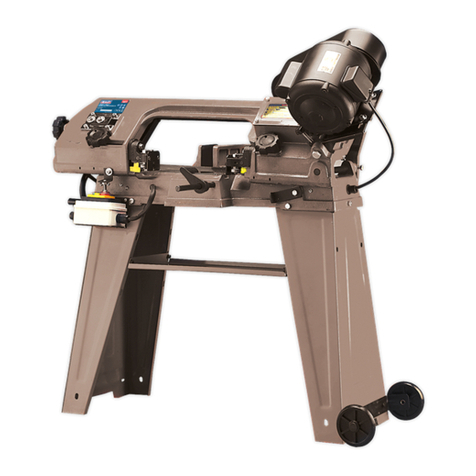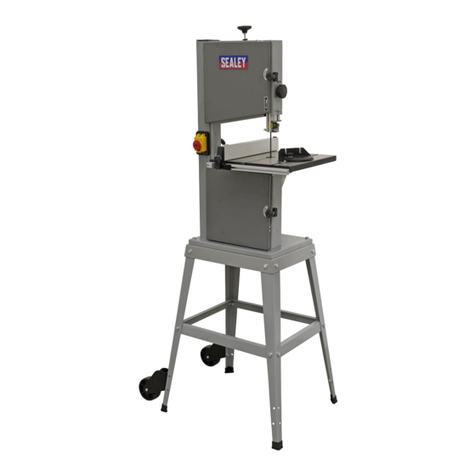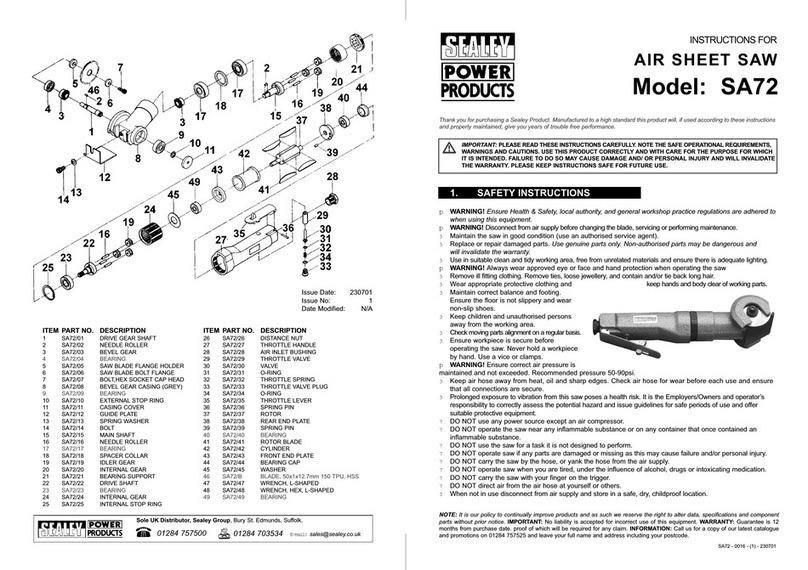5. OPERATION
WARNING! Before operating the bandsaw read the entire
manual to familiarise yourself with all aspects of the
machine. Pay particular attention to the Safety
instructions in Section 1.
NOTE: Before operating the machine certain checks and
adjustments will need to be carried out as detailed in
Section.4 ‘Set Up and Adjustments’. It is very important
that these instructions are followed carefully in order that
the machine is set up safely and correctly.
WARNING! The machine is designed for metal cutting
work in engineering workshops, garages, metal fabricators,
etc. The SM355CE must not be used to cut any other
materials (including wood). To do so will invalidate your
insurance cover and your warranty and may cause damage
and/or personal injury.
WARNING! Never operate the saw unless all blade guards are
installed and working properly.
Fig.15
hitting the red emergency OFF button. Refer to the
‘Troubleshooting’ section for common problems).
5.1.12 The coolant pump starts automatically when the machine is
turned on and feeds coolant directly to the blade guides. The
flow can be regulated using the coolant feed tap as described
in section 4.1.
5.1.13 When the cut is completed the machine will switch off
automatically. Turn the mains power switch off and disconnect
the saw from the power supply, raise the blade and remove
the workpiece. Wear gloves as the workpiece will be hot and
have sharp edges.
5.1.14 Hand grip start. The handgrip is used in conjunction with the
hydraulic damper to provide an extra degree of control,
especially when the blade first comes into contact with the
workpiece. Furthermore the hand grip switch has to be held
down to keep the blade running so the machine can be
stopped quickly by releasing the switch if problems occur such
as the blade jamming.
5.1.15 In order to start the machine with the hand grip switch (See 5
in Fig.4) the selection switch on the control panel (See 3 in
Fig.15) must be turned to the hand grip symbol.
5.1.16 Set the blade rotating by holding down the handgrip switch.
Having previously set the rate of descent allow the blade to
move slowly down towards the workpiece by turning the
hydraulic tap to be in line with the cylinder. Allow the blade to
rest lightly onto the workpiece whilst making the initial cut.
Keep the switch held down whilst the cut progresses. (If the
blade should jam or other problems occur release the hand
grip switch immediately).
5.1.17 The coolant pump starts automatically when the machine is
turned on and feeds coolant directly to the blade guides. The
flow can be regulated using the coolant feed tap as described
in section 4.1.
5.1.18 When the cut is completed the machine will switch off
automatically. Turn the mains power switch off and disconnect
the saw from the power supply, raise the blade and remove
the workpiece.
WARNING! Never raise blade when machine is running.
WARNING! Wear gloves when handling sawn metal parts
as the cutting process will have made them hot to touch
and the cut edges will be sharp.
WARNING! Do not rotate the bow when the machine is
running.
5.1.1 Ensure that the saw is disconnected from the power supply.
5.1.2 Adjust the stop bracket to the desired length on the stop rod
as described in Section 4.4
5.1.3 Adjust the vice to the desired angle or set up at 90° to the
blade as required and as described in Sections 4.4 and 4.5
5.1.4 Open vice, insert the workpiece and clamp it securely.
5.1.5 Adjust the blade guide so that it is close to the workpiece as
described in Section 4.8
5.1.6 Adjust the rate of descent of the arm as described in Section
4.2 so that it is creeping slowly down towards the workpiece.
Shut off the hydraulic cylinder when the blade gets close to
the workpiece. DO NOT start cutting on a sharp edge. File it
off first. DO NOT turn on machine until workpiece is secured
and blade has been lowered to just above workpiece.
5.1.7 Before starting the machine ensure that the bed cannot
rotate by moving the lever on the front face of the machine
bed to the locked position i.e. fully over to the right.
(See 20 in fig.4)
5.1.8 Turn on the mains power by turning the switch clockwise.
See (1) in Fig.15 above. The power lamp (2) will light.
5.1.9 Using switch (3) select whether the machine will turn on with
the Start Button (4) on the control panel or the handgrip
switch. See (6) in Fig.4.
5.1.10 Control panel start. Start the saw by pressing the start
button on the control panel.
5.1.11 Having previously set the rate of descent allow the blade to
descend slowly onto the workpiece by turning the hydraulic
tap to be in line with the cylinder. (If the blade should jam or
other problems occur immediately switch off the power by
6. MAINTENANCE
WARNING! Disconnect the bandsaw from the power source
before servicing, changing accessories, or performing any
other maintenance.
6.1.1 Check the gearbox oil level on a monthly basis. This should
be done with the bow raised to its highest position. Observe
the oil level in the sight glass on the side of the gearbox. If
required, top up the oil by removing the filler bolt from the
upper part of the gearbox just below the motor. Change the oil
every 6 months. The drain plug is at the bottom of the
gearbox. Drain the gearbox with the bow in its highest position.
6.1.2 Keep all surfaces clean and free from rust, slag, chips and
coolant build-up.
6.1.3 Do not use compressed air to clean bandsaw. Compressed air
may force chips into the guide bearings and other critical areas
of the saw.
6.1.4 Use a small paint brush or parts cleaning brush to remove
metal particles.
6.1.5 Wipe saw down with a clean dry cloth and oil all unpainted
surfaces with light machine oil.
6.1.6 Keep blade guides clean and free from metal chips.
6.1.7 Check guide bearings frequently to make sure they are
properly adjusted and running freely.
6.1.8 BLADE CLEANING BRUSH. It is important that the blade
cleaning brush be properly adjusted and kept in good working
order. The brush is mounted behind the fixed blade guide.
(See 'H' in Fig.12) Blade life will be shortened severely if the
brush is allowed to go out of adjustment, becomes worn or
damaged. Replace the brush if it becomes worn or damaged.
6.1.9 Clean out the coolant tank at least twice a year.
WARNING! DO NOT attempt to to adjust the blade brush
with the machine running. Adjust only when the machine
is disconnected from the power source.
Original Language Version SM355CE Issue: 3 - 24/03/10
